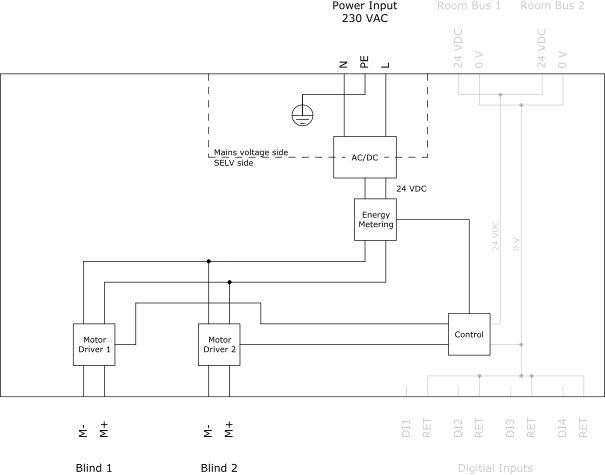
Concept
Low-Voltage Blind Outputs
The low-voltage blind modules have two Blind outputs for control of motorized window blinds that are powered by 24 VDC.
The Blind output connector has two terminals for blind motor control and power distribution:
M+
M-
The connector has a 5-pole frame, but only two poles are used in this application. For more information, see RP Controller Expansion Module Pluggable Connectors .
The two outputs are independently controlled. The blind module uses a motor driver to control each output and drive the motor connected to the output. At startup, the motor drivers are in low power standby mode with the outputs at high impedance.

The module's AC mains voltage side and low-voltage side (SELV side) are galvanically separated through the AC/DC converter.
The module also has energy metering circuitry that supports the measurement of the energy consumption for the total load connected to the module. For more information, see RP Controller Expansion Module Energy Metering .
The blind module is designed for use with blind motors with automatic end stop detection. The blind module requires a defined end stop at the top position. An end stop at the bottom position is recommended, but not required.
To move the blinds up or down, the blind module controls the motor driver so that the 24 VDC is connected to the blind motor with one polarity or the other polarity to control the direction of the blinds. For venetian blinds that use one motor to control both the position of the blinds and the angle of the slats, the angle is also controlled through these two terminals. The mechanics of the venetian blinds is such that the up/down movement of the blinds begins with a rotation of the slats. This initial phase of the up/down movement is used to control the angle of the slats, by connecting the 24 VDC to the blind motor only for a short time period.
To achieve absolute control of the position of the blinds and the angle of the slats, measurements and calibration need to be performed during commissioning. The time it takes for the blinds to travel from the bottom to top position, and from top to bottom position, needs to be measured. The time it takes for the slats to fully rotate in one direction, as well as the opposite direction, needs to be measured. The results from the measurements are entered in the EcoStruxure Building Operation software to calibrate the position of the blinds and angle of the slats. For more information, see Configuring Blinds in RP Controller Expansion Blind Low Voltage Power Modules .
Specifications
Outputs
|
2, Blind 1 to Blind 2
|
Output terminals
|
M- and M+
|
Output voltage
|
24 VDC
|
Maximum load current
|
Maximum 1 A load per output
|
Maximum 1.3 A total load for the 2 outputs
|
|
Maximum 2 A starting current (<100 ms) per output
|
 RP Controller Expansion Modules
RP Controller Expansion Modules
 Blind Modules
Blind Modules
 RP-C-EXT-BL-2-LV-PD
RP-C-EXT-BL-2-LV-PD
 RP Controller Expansion Module Pluggable Connectors
RP Controller Expansion Module Pluggable Connectors
 RP Controller Expansion Module Energy Metering
RP Controller Expansion Module Energy Metering
 Configuring Blinds in RP Controller Expansion Blind Low Voltage Power Modules
Configuring Blinds in RP Controller Expansion Blind Low Voltage Power Modules